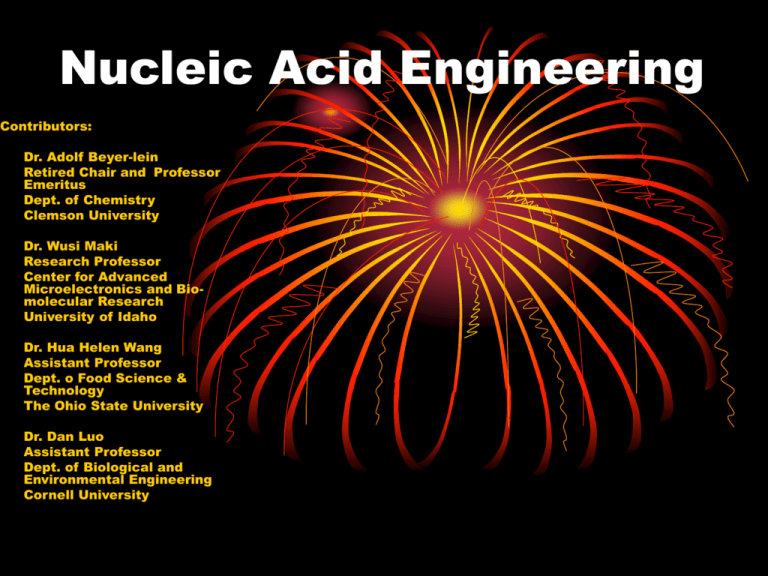Nucleic Acid Engineering
advertisement

Nucleic Acid Engineering Contributors: Dr. Adolf Beyer-lein Retired Chair and Professor Emeritus Dept. of Chemistry Clemson University Dr. Wusi Maki Research Professor Center for Advanced Microelectronics and Biomolecular Research University of Idaho Dr. Hua Helen Wang Assistant Professor Dept. o Food Science & Technology The Ohio State University Dr. Dan Luo Assistant Professor Dept. of Biological and Environmental Engineering Cornell University Background and Rationale • Nucleic acid engineering is a bottom-up nanotechnology approach. • Nucleic acid engineering is focusing on creating novel materials by intelligent design at the nano scale. • Nucleic acid engineering is a platform of technology that can be applied to a myriad of applications in the agriculture and food system. • Nucleic acid engineering is an evolving new field of study. Background and Rationale • Nucleic acid engineering is a multidisciplinary technology, encompassing: molecular biology, chemistry, microelectronics, polymer sciences, etc. • Knowledge and technology developed from health sciences (e.g., from NIH) and plant could be borrowed and adapted to animals and other agricultural system by nucleic acid engineering (analogy: similar road signs) • Nucleic acid engineering can be combined with microelectronics, chemistry, polymers and biomolecular research to yield more potential building block at the nanoscale. Examples: chemically modified nucleic acids, DNA molecule doping (DNA conductor, Dr. Alocilja, Biosystems Engineering, Michigan State Univ.), polymerDNA hybrids, etc. Background and Rationale • Nucleic acid engineering is a platform technology that can find a myriad of applications for the agriculture and food systems, examples (in no particular order): • Signal amplification • Bio-separation/Bio-films • DNA delivery (gene therapy/vaccination/Disease prevention) • Vet. Medicine • Bioprobes • Biosensor • Nanomaterials for agriculture and food Specific opportunities in theme area • Novel nanomaterials by design • DNA nanowires • DNA-microelectronic hybrids • Molecular recognition and/or molecular probes for pathogen detection • DNA delivery for value added animal/plant products • Veterinarian medicine (gene therapy, DNA vaccination, disease diagnosis and prevention) • Transgenic/cloning research • Bioseparation/biofilms Specific opportunities in theme area • Bioselective surfaces (different molecules to DNA; DNA pattern at the surface, porous metal with DNA, controlled pore size of DNA film, controlled molecular structure for filtration (example: protein separation from corn, Cargill), etc.) • Nanoprocessing: DNA resist/DNA photolithography (DNA is a good sacrificial materials), DNA nanocircuits • Biosecurity (DNA sensing for specificity? Multi-probes? DNA barcoding?) • Environmental processing (?) • Sustainable Agriculture (?) Priorities for CSREES • Obesity, Human Nutrition, and Food Science • Genomics and Future Food and Fiber Production and Quality • Agricultural Security • Food Safety Potential outcomes and impacts of the research • We can build nano-electronic products and devices that combines both organic and inorganic components for agricultural applications • • • More control in scale (carbon nanotubes) More specific More quantitative • We can create nano-materials that can be designed and controlled at the nanoscale • We can detect, with high specificity and multi-functionalities, pathogens for food safety and in the veterinarian medicine (diagnosis). • We can develop DNA delivery systems for value added agricultural products (animals and plants) and other applications (transgenic, cloning, assisted reproduction, etc.) Potential outcomes and impacts of the research • We can design new separation methods and/or novel DNA films with more sophisticated and controllable microstructure for agricultural applications (e.g., protein separation from agriculture products). • We can impact veterinarian medicine (diagnosis, therapy, disease prevention, etc.) • We can demonstrate bottom-up approach in agriculture and food systems, thus impact nanotechnology in general. • We can achieve other impacts! Input for recommended budget priorities • Rationale: • 30 million total (NSEAFS) • 3.6 million for nucleic acid engineering • • • • On average, $200k/grant/year 11 Fund. Research projects 3 Exploratory projects Center for challenge: 1-(2) might be needed for NSEAFS − Will contribute 200k • 300k for infrastructure (2-3 awards) • 320k for education − 1 REU (contribution) − 4 graduate fellowships (for 4 years)






